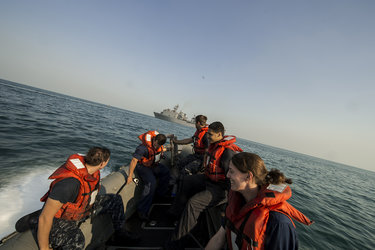To prevent drowning, remember two things: location and life jackets
ALBANY COUNTY — To prevent drowning, wear a lifejacket, says Sergeant Neil Case, who leads the New York State Police Underwater Recovery Team.
To save someone who’s drowning, try to remember where they went under so you can pass the information on to trained rescuers.
Those are the two most important pieces of advice Case gave when The Enterprise — prompted by a number of recent local drownings — asked him how to stay safe in the water, and what someone should do when they see someone who’s drowning or is at risk of it.
In the United States, around 11 people die each day from drowning, or more than 3,500 people each year, with around 165 of those deaths occurring in New York State, according to data from the Centers for Disease Control. Just this summer, The Enterprise has covered three local drownings, two of which occurred in Thompsons Lake.
The vast majority of drownings in New York happen in unsupervised waters. In Albany County between 1987 and 2000, there have been only two drownings in regulated waters, or those that are required to be overseen by a lifeguard, such as a public beach or community pool.
Meanwhile, the state police underwater recovery team performed 24 recoveries of dead bodies last year, but no rescues, with the majority being in lakes, Case said.
Part of that is because the team is spread out over a wide area and generally reaches people only after they’ve drowned, whereas local agencies like fire departments, or even civilians, might have a better chance at retrieving someone who’s begun drowning.
“[Our] response time alone can sometimes be well over an hour,” Case said, “especially if we have to stop someplace and get our boat ... The majority of the time, the fire department will be on scene before police divers because your local fire department typically lives in that area.”
A quick rescue is crucial for drowners, which is why Case tells people to always wear life jackets. Wearing a life jacket not only helps to keep someone’s head above water if they fall in unexpectedly, but prevents someone from sinking once their lungs take in water and they lose their ability to float.
Case urges observers to try to keep track of where a person went under so that rescuers can search the right area.
“Golden hour”
“In the world of drowning, there’s what we refer to as the ‘golden hour,’” Case said, explaining that, due to the mammalian diving reflex, “your body ships all of its blood to its vital organs to try to keep them alive. So within that first hour of somebody submerged in the water, we’re still in rescue mode because we can still save that person. Even if they’ve drowned and they have no pulse, there’s still the potential to save somebody.”
He added that colder water and a younger victim make for better chances of revival.
While the body’s reflex when diving can preserve its functioning, another reflex, called the cold-shock response, is often the reason someone has drowned in the first place, since the natural response to sudden cold exposure is to gasp, Case said.
“Most of the water we see in upstate New York is actually pretty cold, and you could easily be taken by surprise when you hit that cold water,” he said.
Other factors, like getting hit in the head by a capsizing kayak or falling canoe paddle, can also cause drowning, he said.
According to a review of drowning studies published last year, water entering someone’s airways typically takes place within a minute of struggling for those who are unable to swim, whether because they don’t know how or because they’re prevented from doing so for any reason.
For those who can swim, that time is delayed by however long a person is able to swim for, but cold water can make swimming harder,the studies say.
Subtle signs
And while lifeguards are trained to spot the signs of someone drowning, casual observers might miss them, as those signs can be more subtle than what people would expect, Case said.
“A lot of times, with a drowning victim, people don’t even realize they’re drowning because, most of the time, they’re right at the surface and they appear calm,” he explained, adding that a typical appearance is “a person with their head back, looking towards the sky because they’re doing whatever they can to keep their mouth and nose above water.”
That’s because, again, people rely on instinct, as observed by the lifeguard Frank Pia, who published a seminal article in the Journal of Physical Education in the 1970s on his study of victim behavior during drowning incidents.
Both Case and Pia noted that people who are drowning are unlikely to call for help, sometimes because they’ve taken in water, causing the larynx to spasm and block airflow, as Case explained. Otherwise, they may simply be too focused on breathing, as Pia wrote.
Victims will also not wave for help, Pia wrote, because their arms are being used to propel themselves upward; similarly, their arms can’t be used to move them closer to land, despite the victim typically being aware of where land is and orienting themselves in that direction.
Civilian rescue tips
The first thing someone should do when they see someone drowning is call 9-1-1, Case said. If the victim has been brought to land and there are no first responders, Case said it’s important to perform CPR, cardiopulmonary resuscitation, and that 9-1-1 operators can walk a person through those steps.
However, Case said it’s unwise to try to rescue someone from the water, since their instinct will be to grab onto the rescuer and push them down to bring themselves up and above water, oblivious to the danger they’re putting the rescuer in.
Nevertheless, Case said that people should know the sequence that trained rescuers follow, which is known as “Reach, Throw, Row, Go.”
Reaching involves using a long object like a ladder or pole to provide the victim something to grab onto. Throwing refers to tossing out a buoyant object that the victim can use to stay above water more easily. Rowing means to bring a boat up alongside the person, and go means going into the water to rescue the person.
But the most important thing a civilian can do is remember where a person went under, Case said, since it’s more likely than not that a person will submerge before they’re able to be rescued, and once the person’s lungs are filled with water instead of air, they’ll sink to the bottom of whatever body of water they’re in, making them invisible to a rescue and recovery team.
“If they can line up where the person was with something on the opposite shoreline to try to give us that good location, that’s really helpful,” he said. People on boats, he said, often have the ability to mark the exact spot of submersion using a “man overboard” button on a GPS, a Global Positioning System, or other technological assistance.
Ultimately, though, Case said that the chances of saving someone who’s drowned are slim, except when there’s “phenomenal visibility, where you can see the person, see them go under, and see them on the bottom.”
“But as far as any first responders responding and finding the person underwater and saving them, it can happen, but it’s very seldom that it does.”
So, he reiterated, the best thing to do is wear a lifejacket to prevent drowning from taking place at all.
“I’ve been doing this for 16 years,” he said, “and I’ve never recovered a drowning victim who was wearing a life jacket … The most important thing to do is wear a lifejacket. It’s a very simple concept.”



